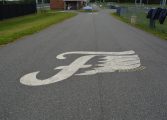Work on ornamentals and yard trees to improve shape, prevent disease and repair damage. Face the fact that it may be time to remove trees and shrubs which are overcrowded. Decide the winner and remove the competition. Do some ‘cross-your-heart’ pruning; that is, lift and separate. An obvious indication of overcrowding is plants branching on one side and leaning way out to get a bit of sun. If they are small enough, transplant to a more open location; if large enough, remove some lower limbs to make a higher shade canopy. If they can’t reach a mature height and can’t be tamed to continue at a reduced size, cut them down. They won’t be missed and all will look better and be healthier in the long run.
To help my weeping Japanese maples, I often use separators, a flat stake cut to the length of the space I want to open with a fork or ‘V’ cut into each end or use commercially available plastic separators. Place them where they can open the space between the weeping branches. I sometimes lie under the tree and remove branches which can’t compete for sunlight and I stake one of the top most branches to lift the new growth several inches.
I have a row of willows which I prune at a certain height so that the new growth will spurt 8 – 10 feet from the cut and screen out an unwanted view. I try to control an unruly abelia hedge in winter by cutting several feet off of 1/3 of the main stems and then thin it by removing some of the oldest canes. I shape spirea and barberry, take dead stalks out of the lilacs and trim the wonderful ‘Major Wheeler’ red honeysuckle.
Prune with purpose. Deciduous trees show their shape in winter and I work on trees that leaf out early first, such as birch and maple. Examine branches for disease and remove or spray with dormant oil. Remove crossing or broken branches and those growing at too tight an angle with the trunk. Thin the canopy to let in light and always cut to an outward facing bud or branch. Work slowly and stand back from time to time.
Remember to disinfect your tools (10% solution of rubbing alcohol and water; 2 tablespoons/cup) and keep them sharp. Be sure ladders are well placed. Wear eye protection and gloves. Remember that it is always good to work when someone else is around in case of injury.




